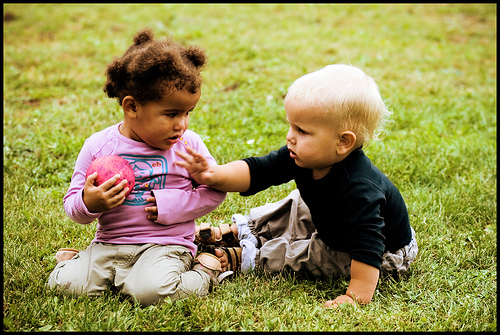Babies sometimes do things that may seem aggressive, like pulling hair, biting and hitting. This doesn't mean that they are doing it to hurt or annoy you and it's not uncommon. Young children are still learning to understand and control their feelings as well as figuring out which words communicate their thoughts.
Frustration and aggression can be the result from many diverse situations, for example:
Another great way to keep track of your child's behavior and development is through the Ages and Stages Questionnaire!
Frustration and aggression can be the result from many diverse situations, for example:
- A toddler who doesn't get his/her way
- When a child isn't expecting a transition to a new activity and they're focused on something else
- When they have everything they want and someone tries to take it
- Recent changes in their lives (new baby, parent on a business trip, new school year, potty training,etc.)
Another great way to keep track of your child's behavior and development is through the Ages and Stages Questionnaire!
 |
| Photo Print |
Here are some tips from Zero To Three website; to help teach your child how to cope with aggression and learn self control in the early years.
- Stay calm: The calmer you are, the more quickly your child will calm down.
- Recognize your child’s feeling or goal: "You want to stay longer at the playground, and are mad we have to leave. It’s okay to be mad, but it is not okay to hit mommy. Hitting hurts".
- Use gestures along with your words to communicate with your toddler: Use a calm, firm (not angry) voice. At the same time, use a “stop” or “no-no” gesture.
- Offer alternatives: Give your child acceptable ways to reach his goal. Instead of throwing balls in the house, offer your child a soft sponge ball to toss inside, or take him outside for “pitching” practice.
- Try a distraction: Ignore your child’s tantrum and instead, do something she doesn't expect: point to a bird outside, start to read a book she loves, or pick up an interesting toy and start to play with it.
- Suggest ways to manage strong emotions: When your child is really angry, suggest that he jump up and down, kick a ball, rip paper, cuddle with a teddy bear or use some other strategy that you feel is appropriate. This teaches your child to express strong feelings in healthy, non-hurtful ways.
- Help your child take a break: Some children calm more quickly when they can be by themselves in a safe, quiet place. It helps children learn to soothe themselves and regain control. When your child pulls herself together, tell her what a good job she did calming herself down.
If you would like an Ages and Stages Questionnaire that focuses on your child's Social and Emotional development, please call 2-1-1 and ask for Help Me Grow.

No comments:
Post a Comment
Note: Only a member of this blog may post a comment.